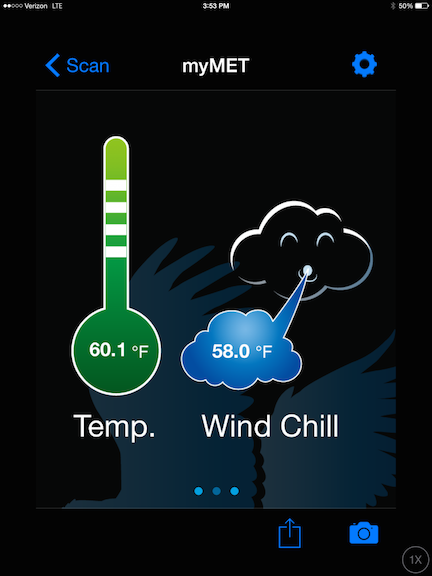Fun and Science with the Weatherhawk myMET digital Windmeter
By Martin Horejsi
Posted on 2015-04-15

Checking the windspeed on the Slickrock trail in Moab, Utah. The air was moving at a steady 18 miles per hour. Just enough to make you a little nervous when bicycling along cliff edges. As you can see in the picture the neck lanyard is being pushed away by the wind. Until another indicator was added, the lanyard was used to position the meter correctly for accurate readings.
The Weatherhawk myMET Windmeter
Measuring wind speed is just one of the many facets of exploring climate science. Wind, or the natural noticeable movement of air is created and changed by many well-known factors including temperature, barometric pressure, landscape, and time of day among others.
The use of a digital anemometer allows students to put a quantity on wind speed and a compass will provide direction. Add temperature and you can calculate wind chill. Note the time of day and you can create a detailed date picture of local air movement.
Popular anemometers are often cups or propellers. The myMET uses an eight-blade propeller about an inch (2.54cm) in diameter. The meter and electronics reside an retractable plastic housing that uses a thumb-slider on the right side. A tripod mount is on the base. The meter runs on two CR2032 button batteries contained in a reverse-threaded (turn right to loosen) O-ring sealed comparment.
The Weatherhawk myMET is a powerful solution to measuring windspeed and temperature as both a standalone device, and in tandem with a tablet such as the iPad. Alone the myMET wind meter provides wind speed, air temperature, and wind chill. But paired via Bluetooth to a comparable iOS or Android device, the meter’s measurements are recorded on one of three screens as well as a data overlay on a photograph taken by the tablet’s camera. myMET outputs the wind speed in miles per hour or meters per second, and temperature in Fahrenheit or Celsius. Here are some examples:
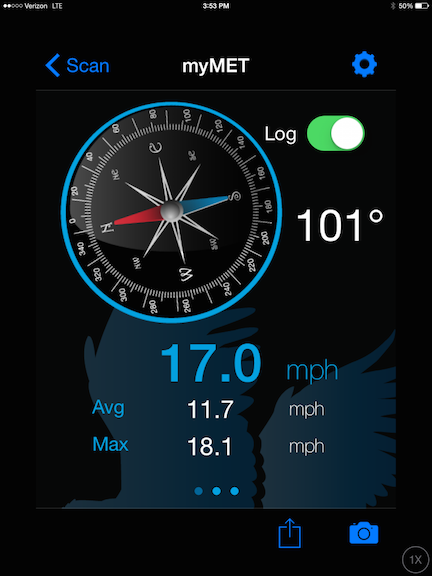
Average and Maximum wind speed along with a compass using the onboard tablet sensor so there must be alignment between the myMET meter and the tablet.
To assist in keeping the myMET perpendicular to the wind direction Weatherhawk offers a tripod-mounted weather vane attachment that holds the myMET. For my tests, I used the included lanyard to position the meter, but later added a length of yarn since the meter could be dropped if the neck strap is not used for its intended purpose.
Below are some images where the myMET wind speed meter was tested along with some lessons learned along the way.
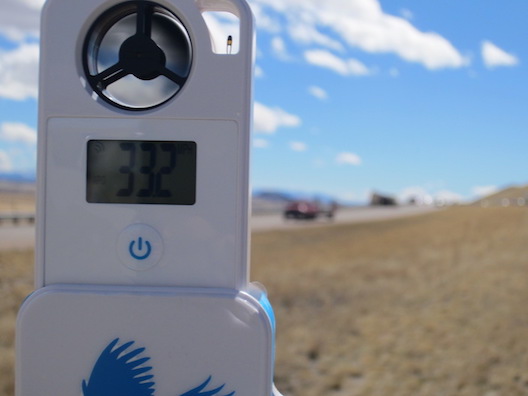
In this image, the windspeed is gusting 33 miles an hour. In the background is a semi truck and trailer that blew over on the interstate highway when the gusts were a little higher just minutes earlier.
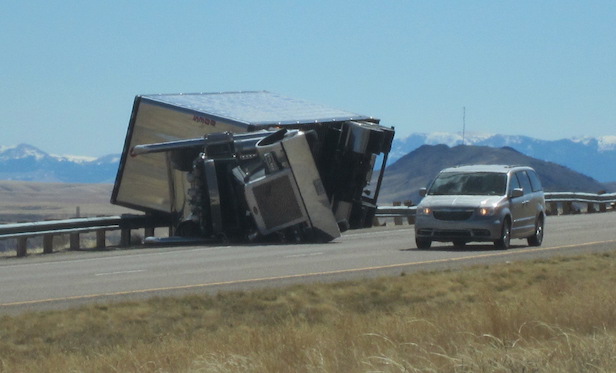
Here is a closeup of accident. It must have been some gust since this northbound truck was mirrored by a complementary southbound truck that also blew over just a few hundred meters away.
Here is a link to the local news outlet mentioning that there were no serious injuries of anyone involved.
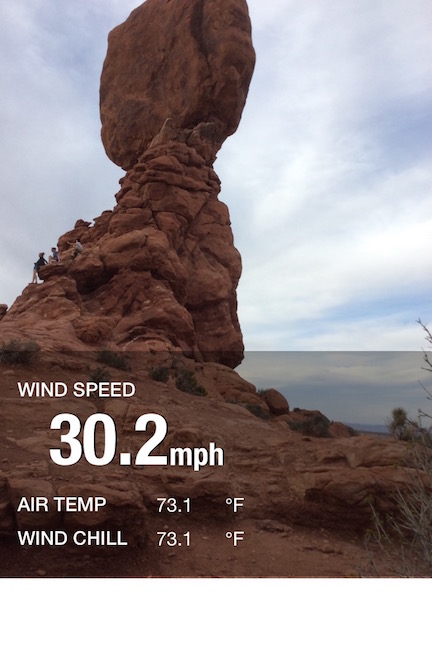
Balanced Rock in Arches National Park is a shocking artifact of erosion. The massive boulder is constantly buffeted by wind on the high desert plain. Using the iPad camera and myMET meter, the image documents both the place and the windspeed.

Wind farms are cropping up where wind is both steady and directionally consistent. High speed wind or heavy gusts are not ideal. In the photo a steady 8 mph wind is spinning the massive turbines just fine. Also, you can see the yarn added to the meter to help keep the meter perpendicular to the wind direction.
With the increased emphasis on green energy especially wind power, being able to collect accurate numbers for air movement both over time and maximum speed the beginning of some great science and discussion. Hearing or reading a wind speed value is a daily occurrence, but understanding what the numbers feel like takes first-hand experience.
This chart shows the miles per hour of wind compared to physical indicators.
|
Speed (mph) |
Designation |
Description |
|
1-3 |
light air |
smoke drift indicates wind direction |
|
4-7 |
light breeze |
weather vane moves, leaves rustle |
|
8-12 |
gentle breeze |
leaves and twigs in constant motion |
|
13-18 |
moderate breeze |
dust and loose paper raised, small branches move |
|
19-24 |
fresh breeze |
small trees sway |
|
25-31 |
strong breeze |
large branches move, wind whistles wires |
|
32-38 |
moderate gale |
whole trees move, walking affected |
|
39-46 |
fresh gale |
twigs break off trees, walking difficult |
|
47-54 |
strong gale |
slight structural damage occurs, branches break |
|
55-63 |
whole gale |
trees uprooted, considerable structural damage |
|
64-74 |
storm |
widespread damage |
|
75+ |
hurricane |
severe and extensive damage |
While Weatherhawk does offer a padded case for the myMET, I opted for a ridged case that could take rough student handeling. The myMET seems quite durable on its own and the retracting case that protects the moving parts is probably plenty for most uses. Their padded case is a notch above that. And my Outdoor Products hard case (for sunglasses) is yet another notch higher.
Once back in the classroom, I wondered about using the meter to answer a question I’ve had for a while. What is the windspeed of various sizes and types of fans at different distances. The results will blow you away. Here’s a chart from the KidWind Project to get you started.
Disclaimer: The views expressed in this blog post are those of the author(s) and do not necessarily reflect the official position of the National Science Teaching Association (NSTA).




